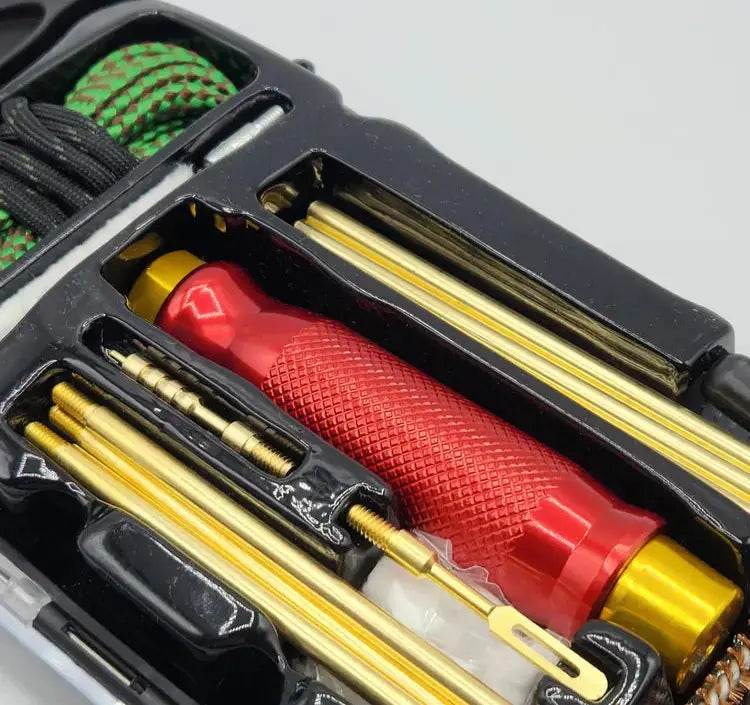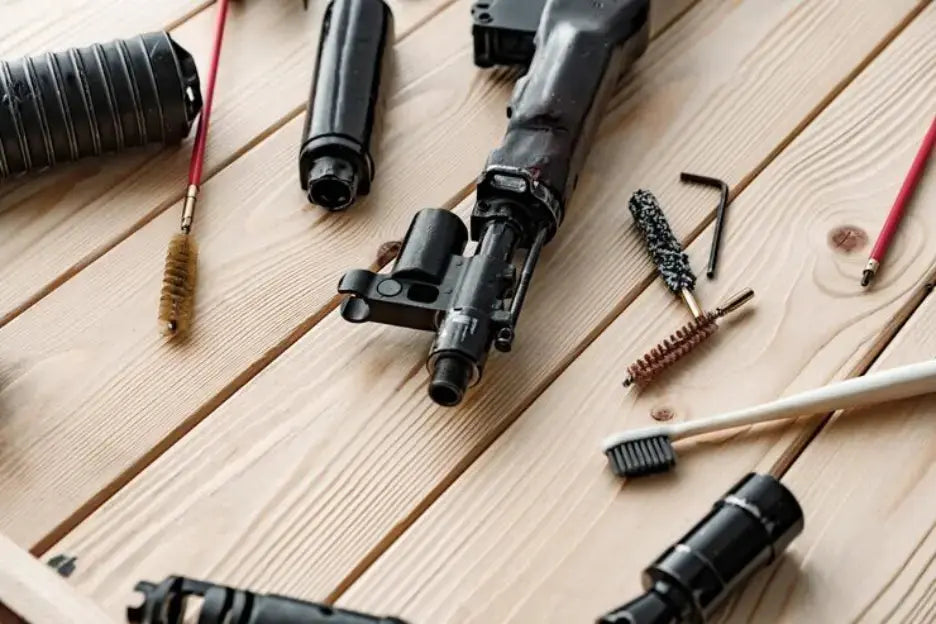When it comes to gun ownership, one question often arises: how often to clean a gun? The answer isn't straightforward, as it depends on various factors including the type of firearm, usage frequency, and the conditions in which it is stored. Maintaining your firearm is crucial for its longevity and reliability. Understanding the best practices for cleaning your gun will ensure that it performs optimally when you need it most. Let's take a look at some of the basics behind gun cleaning so that you can get the most longevity out of it.

Importance of Regular Gun Cleaning
Regular gun cleaning plays a pivotal role in maintaining the performance and safety of your firearm. Over time, residue from gunpowder, dirt, and moisture can accumulate within your gun, leading to potential malfunctions and diminished accuracy. A well-maintained firearm ensures the firing mechanism operates smoothly and consistently, which is crucial whether you're at the range or in a defensive situation.
Beyond performance, regular cleaning prevents rust and corrosion. Metal components, when exposed to moisture and the elements, are susceptible to these forms of degradation. By routinely cleaning and lubricating your firearm, you protect your investment and ensure its longevity. The aesthetic appeal of a well-kept gun is an added bonus, reflecting the care and respect you have for your equipment.
Moreover, regular cleaning allows you to inspect your firearm closely. This practice makes it easier to spot any wear and tear or potential issues before they escalate into significant problems. Identifying and addressing these early on can save you from costly repairs and enhance your shooting experience. Overall, incorporating regular cleaning into your firearm maintenance routine is essential for reliability, safety, and longevity.
Understanding the AR-15 and Its Relatives
The AR-15 platform is a hallmark of modern firearms, celebrated for its adaptability and effectiveness in various scenarios, from recreational shooting to home defense. At its core, the AR-15 utilizes a direct impingement gas system, which, while efficient, tends to accumulate carbon and fouling more rapidly than some other designs. This characteristic necessitates a more consistent cleaning regimen to ensure optimal performance and reliability.
The modular nature of the AR-15 allows for extensive customization, but it also means that each modification can affect how and when you need to clean the firearm. For instance, adding a suppressor can increase backpressure, leading to faster carbon buildup. Understanding these nuances will help you tailor your cleaning practices to fit your specific setup.
Relatives of the AR-15, such as the M4 carbine or the AR-10, share similar maintenance needs but may have slight variations due to differences in caliber, barrel length, or gas system design. Regardless of the specific model, these firearms generally benefit from a proactive cleaning approach. Knowing the ins and outs of your particular gun, including its unique mechanisms and potential problem areas, allows for more effective maintenance.
Factors That Determine Cleaning Frequency
Several factors influence how often you should clean your gun. First and foremost, the frequency of use is a major determinant. If you're hitting the range regularly, your firearm will naturally accumulate more residue and require more frequent maintenance. Additionally, the type of ammunition you use plays a significant role. High-quality ammo tends to produce less fouling compared to cheaper, bulk options, which can leave more residue in your barrel and action.
Environmental conditions are another critical factor. Shooting in dusty, wet, or muddy conditions will necessitate more frequent cleaning to prevent potential malfunctions and corrosion. Storage conditions also matter; a firearm stored in a humid environment is more prone to rust and may require additional cleaning to ensure it remains in top condition.
The specific type of gun you own can also influence your cleaning schedule. For instance, the AR-15 and its relatives, like the M4 carbine or AR-10, often require more diligent cleaning due to their direct impingement gas systems, which can accumulate carbon and fouling more rapidly.
Lastly, consider any modifications or accessories added to your firearm. Attachments like suppressors can increase back pressure and carbon buildup, necessitating a more rigorous cleaning routine. By accounting for these factors, you can develop a cleaning regimen tailored to your specific firearm and usage habits, ensuring optimal performance and longevity.
Basic Cleaning vs. Deep Cleaning: What's the Difference?
Basic cleaning and deep cleaning serve distinct roles in firearm maintenance. Basic cleaning is your go-to routine after each shooting session. It involves straightforward tasks like wiping down the exterior, running a bore snake through the barrel, and lubricating the moving parts. This quick maintenance helps remove immediate residues like powder and fouling, ensuring your gun remains functional and ready for your next outing.
Deep cleaning, however, is a more comprehensive process, often necessary after extensive use or exposure to harsh conditions. This involves disassembling the firearm, thoroughly scrubbing each internal component, and meticulously inspecting for any signs of wear or damage. It's about getting into the nooks and crannies, removing buildup that basic cleaning might miss, and ensuring every part is in top condition.
Understanding the difference between these two levels of maintenance is crucial. Basic cleaning keeps your gun operational on a day-to-day basis, while deep cleaning ensures its long-term reliability and performance. Balancing both types of cleaning in your routine allows you to maintain your firearm effectively without unnecessary wear and tear from over-cleaning. This way, you can enjoy a well-functioning, reliable gun for years to come.

Recommended Cleaning Schedule for AR-15s
An AR-15 benefits from a structured cleaning schedule to maintain its performance and reliability. Begin with a basic cleaning after each use. This quick routine involves wiping down the exterior, running a bore snake through the barrel, and applying lubrication to key moving parts. This immediate maintenance ensures that residues like powder and fouling are promptly addressed.
On a monthly basis, it's prudent to perform a more detailed cleaning and inspection, especially if you've been using the rifle frequently or in challenging conditions. This includes checking the bolt carrier group, gas tube, and other critical components for buildup and wear.
For those who put a lot of rounds through their AR-15, a deep cleaning is recommended every 500 rounds. This involves a complete disassembly, thorough scrubbing of each internal part, and a meticulous inspection for any signs of wear or potential issues. Pay special attention to areas where carbon buildup is common, such as the bolt and gas key.
Regardless of usage, commit to an annual deep cleaning and comprehensive inspection. This helps to catch any issues that might have developed over time and ensures that all parts are in optimal condition. Regularly adhering to this cleaning schedule will keep your AR-15 in top shape, ready for any situation.
Essential Gun Cleaning Equipment You'll Need
To keep your firearm in top condition, having the right cleaning tools is essential. Start with cleaning rods and brushes designed for your specific caliber. These are indispensable for scrubbing the bore and chamber effectively. A bore snake is a quick and efficient tool for routine barrel cleaning, easily removing residue after a shooting session.
High-quality cleaning solvents are crucial for breaking down carbon and fouling. Make sure to choose a solvent formulated for firearms to avoid any potential damage to the finish or internal parts. Equally important is lubrication oil, which prevents rust and ensures smooth operation of the moving parts. Opt for a reputable brand to maintain your gun's functionality.
You'll also need plenty of rags or paper towels for wiping down surfaces and absorbing excess oil. Cotton swabs come in handy for those hard-to-reach areas and small components that require detailed cleaning. Safety should never be overlooked, so always use safety glasses and gloves to protect yourself during the cleaning process.
Investing in quality cleaning supplies might seem costly initially, but it pays off in the long run by ensuring your firearm remains reliable and well-maintained.
Common Mistakes to Avoid When Cleaning Your Gun
Cleaning your gun is a crucial aspect of firearm maintenance, but even experienced owners can stumble into some common pitfalls. One of the biggest mistakes is skipping the cleaning process altogether after a shooting session. It might seem like a hassle, especially after a quick trip to the range, but even minimal residue can lead to significant issues down the line.
Using the wrong cleaning products is another frequent error. Not all solvents and oils are created equal; using products not designed for firearms can damage your gun's finish or internal components. Stick to trusted, firearm-specific products to ensure you're not doing more harm than good.
Over-lubricating your firearm can also be problematic. While lubrication is essential for smooth operation, too much of it can attract dirt and lead to buildup. A thin, even layer of lubricant is usually all that's needed to keep things running smoothly.
Neglecting to inspect your gun's components during the cleaning process is another common oversight. Each time you clean your firearm, take the opportunity to look for signs of wear or damage. Catching these issues early can prevent malfunctions and extend the life of your gun.
Lastly, never forget safety protocols. Always treat your firearm as if it's loaded, even during cleaning. Double-check that it's unloaded and practice safe handling at all times to prevent accidents.
By steering clear of these common mistakes, you'll ensure that your gun remains reliable and in peak condition, ready for whenever you need it.
Get the Most Out Of Your Firearm By Getting a Cleaning Kit From GuardTech Plus
Maintaining your firearm's performance and longevity hinges on using the right tools for the job. GuardTech Plus offers premium gun cleaning kits designed to meet the needs of every gun owner, from novices to seasoned enthusiasts. Each kit is meticulously assembled to provide all the essentials you need for both basic and deep cleaning, ensuring your AR-15 and related firearms stay in optimal condition.
GuardTech Plus kits include high-quality cleaning rods, brushes, and bore rope snake tailored to various calibers, allowing you to effectively remove residue and buildup. The kits also feature top-tier cleaning solvents and lubricants, specially formulated to break down fouling without harming your firearm's finish.





